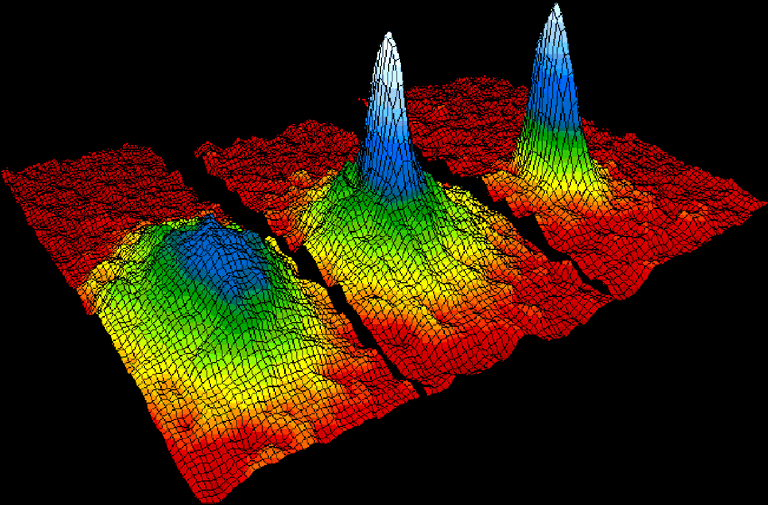In the realm of quantum mechanics, few phenomena capture the imagination quite like the Bose-Einstein condensate (BEC). This extraordinary state of matter, predicted by physicists Satyendra Nath Bose and Albert Einstein in the early 20th century, epitomizes the bizarre behaviors exhibited by subatomic particles under various conditions. Through careful manipulation of temperature and particle interactions, scientists have managed to coax atoms into exhibiting collective properties that defy classical intuition, making the exploration of BECs an intriguing journey into the very heart of quantum physics.
At absolute zero—the theoretical temperature at which all thermal motion ceases—certain bosonic atoms can condense into a singular quantum state. At this frigid juncture, distinct particles behave less like independent units and more like a unified wave, entwining with one another in a remarkable display of coherence. Visualize a grand symphony orchestra where each musician plays in perfect synchrony, creating a harmonious unity that transcends the individuality of the performers. This metaphor aptly describes the behavior of atoms in a BEC, as the ensemble exhibits coherent properties that are fundamentally different from their solitary counterparts.
The essence of a Bose-Einstein condensate lies in the statistic governing its constituent particles: bosons. Unlike fermions—such as electrons, which adhere to the Pauli Exclusion Principle and cannot occupy the same quantum state—bosons, including photons and certain atoms like rubidium-87, can share the same quantum state simultaneously. This intrinsic property allows bosons to accumulate in the same low-energy state as the temperature approaches absolute zero. The resulting condensation leads to phenomena such as superfluidity and superconductivity, both of which defy traditional notions of energy dissipation and viscosity.
The process of creating a BEC is no small feat. Researchers employ sophisticated cooling techniques, often using laser cooling and evaporative cooling to bring the temperature of atoms down to a few billionths of a degree above absolute zero. This meticulous process can be likened to establishing an ultra-sensitive weather station where scientists meticulously monitor and manipulate conditions to ensure that only the right atmospheric elements coalesce into the perfect moment for condensation. As the temperature dips below the critical threshold, the coherent wavefunction of the bosons manifests, leading to the formation of the BEC.
Once achieved, the characteristics of a Bose-Einstein condensate present fascinating avenues for exploration. One of the most striking features is the phenomenon of quantum interference. When a BEC is subjected to external perturbations, the wave-like nature of the condensate allows it to demonstrate interference patterns reminiscent of light waves passing through a double-slit experiment. This pivotal demonstration of quantum behavior not only reinforces the foundational concepts of quantum mechanics but also challenges our understanding of the nature of matter itself.
In addition to offering insights into fundamental physical principles, BECs bear significant implications for future technologies. The unique properties exhibited by these condensates have the potential to revolutionize fields such as quantum computing and precision measurement. For instance, BECs could serve as highly sensitive sensors capable of detecting minute changes in magnetic and gravitational fields. Furthermore, their ability to facilitate exceptionally stable quantum states opens new doors for the development of qubits, the fundamental units of quantum information that could radically enhance computational capabilities.
The quest to comprehend and manipulate Bose-Einstein condensates also invites philosophical inquiry into the nature of reality. This state of matter embodies a profound paradox: it exists both as individual particles and as a coherent macroscopic entity. The emergent properties of BECs challenge conventional views on separability and individuality, weaving a complex tapestry of interconnectedness that echoes themes prevalent in both science and metaphysics. In contemplating the existence of a BEC, one may ponder the broader implications of collective behavior and consciousness itself—how individual components can coalesce into a whole that possesses distinct characteristics not found in isolation.
As research into Bose-Einstein condensates continues to evolve, so too does the potential for groundbreaking discoveries. Pioneering studies have paved the way for manipulations of the condensate through optical lattices and interactions with light, allowing physicists to explore nontraditional states of matter under controlled conditions. As new techniques emerge, the horizon of possibilities concerning BECs expands, suggesting that we may be on the cusp of uncovering even more exotic states of matter with unprecedented applications.
In summary, a Bose-Einstein condensate serves as a testament to the power of collective quantum behavior, transforming individual particles into a cohesive wave-like entity at ultralow temperatures. This phenomenon not only enhances our understanding of quantum mechanics but also opens pathways to innovative technologies and philosophical reflections on the nature of existence. As research in this field progresses, one can expect that the insights gleaned from BECs will reverberate across disciplines, redefining our grasp of the physical world and illuminating the intricate dance between the micro and macro realms of nature.












